Hongxia Xie
RecipeGen: A Step-Aligned Multimodal Benchmark for Real-World Recipe Generation
Jun 07, 2025Abstract:Creating recipe images is a key challenge in food computing, with applications in culinary education and multimodal recipe assistants. However, existing datasets lack fine-grained alignment between recipe goals, step-wise instructions, and visual content. We present RecipeGen, the first large-scale, real-world benchmark for recipe-based Text-to-Image (T2I), Image-to-Video (I2V), and Text-to-Video (T2V) generation. RecipeGen contains 26,453 recipes, 196,724 images, and 4,491 videos, covering diverse ingredients, cooking procedures, styles, and dish types. We further propose domain-specific evaluation metrics to assess ingredient fidelity and interaction modeling, benchmark representative T2I, I2V, and T2V models, and provide insights for future recipe generation models. Project page is available now.
Single Document Image Highlight Removal via A Large-Scale Real-World Dataset and A Location-Aware Network
Apr 19, 2025Abstract:Reflective documents often suffer from specular highlights under ambient lighting, severely hindering text readability and degrading overall visual quality. Although recent deep learning methods show promise in highlight removal, they remain suboptimal for document images, primarily due to the lack of dedicated datasets and tailored architectural designs. To tackle these challenges, we present DocHR14K, a large-scale real-world dataset comprising 14,902 high-resolution image pairs across six document categories and various lighting conditions. To the best of our knowledge, this is the first high-resolution dataset for document highlight removal that captures a wide range of real-world lighting conditions. Additionally, motivated by the observation that the residual map between highlighted and clean images naturally reveals the spatial structure of highlight regions, we propose a simple yet effective Highlight Location Prior (HLP) to estimate highlight masks without human annotations. Building on this prior, we present the Location-Aware Laplacian Pyramid Highlight Removal Network (L2HRNet), which effectively removes highlights by leveraging estimated priors and incorporates diffusion module to restore details. Extensive experiments demonstrate that DocHR14K improves highlight removal under diverse lighting conditions. Our L2HRNet achieves state-of-the-art performance across three benchmark datasets, including a 5.01\% increase in PSNR and a 13.17\% reduction in RMSE on DocHR14K.
RecipeGen: A Benchmark for Real-World Recipe Image Generation
Mar 07, 2025



Abstract:Recipe image generation is an important challenge in food computing, with applications from culinary education to interactive recipe platforms. However, there is currently no real-world dataset that comprehensively connects recipe goals, sequential steps, and corresponding images. To address this, we introduce RecipeGen, the first real-world goal-step-image benchmark for recipe generation, featuring diverse ingredients, varied recipe steps, multiple cooking styles, and a broad collection of food categories. Data is in https://github.com/zhangdaxia22/RecipeGen.
Feature-based One-For-All: A Universal Framework for Heterogeneous Knowledge Distillation
Jan 15, 2025Abstract:Knowledge distillation (KD) involves transferring knowledge from a pre-trained heavy teacher model to a lighter student model, thereby reducing the inference cost while maintaining comparable effectiveness. Prior KD techniques typically assume homogeneity between the teacher and student models. However, as technology advances, a wide variety of architectures have emerged, ranging from initial Convolutional Neural Networks (CNNs) to Vision Transformers (ViTs), and Multi-Level Perceptrons (MLPs). Consequently, developing a universal KD framework compatible with any architecture has become an important research topic. In this paper, we introduce a feature-based one-for-all (FOFA) KD framework to enable feature distillation across diverse architecture. Our framework comprises two key components. First, we design prompt tuning blocks that incorporate student feedback, allowing teacher features to adapt to the student model's learning process. Second, we propose region-aware attention to mitigate the view mismatch problem between heterogeneous architecture. By leveraging these two modules, effective distillation of intermediate features can be achieved across heterogeneous architectures. Extensive experiments on CIFAR, ImageNet, and COCO demonstrate the superiority of the proposed method.
Future Sight and Tough Fights: Revolutionizing Sequential Recommendation with FENRec
Dec 16, 2024
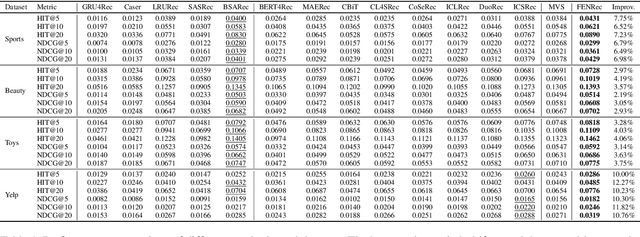
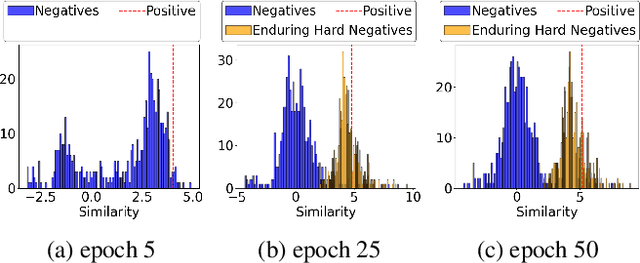
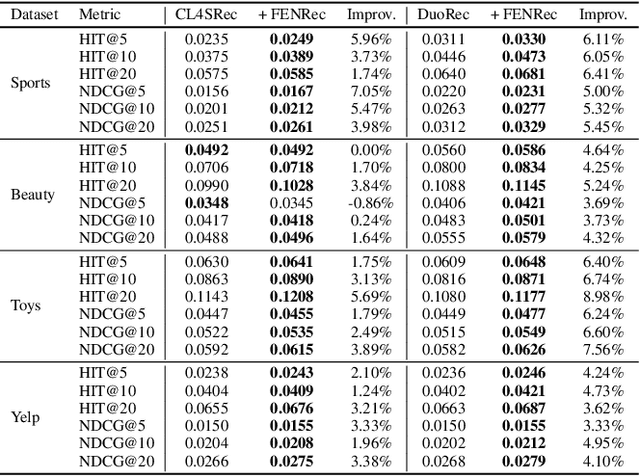
Abstract:Sequential recommendation (SR) systems predict user preferences by analyzing time-ordered interaction sequences. A common challenge for SR is data sparsity, as users typically interact with only a limited number of items. While contrastive learning has been employed in previous approaches to address the challenges, these methods often adopt binary labels, missing finer patterns and overlooking detailed information in subsequent behaviors of users. Additionally, they rely on random sampling to select negatives in contrastive learning, which may not yield sufficiently hard negatives during later training stages. In this paper, we propose Future data utilization with Enduring Negatives for contrastive learning in sequential Recommendation (FENRec). Our approach aims to leverage future data with time-dependent soft labels and generate enduring hard negatives from existing data, thereby enhancing the effectiveness in tackling data sparsity. Experiment results demonstrate our state-of-the-art performance across four benchmark datasets, with an average improvement of 6.16\% across all metrics.
The Fabrication of Reality and Fantasy: Scene Generation with LLM-Assisted Prompt Interpretation
Jul 17, 2024



Abstract:In spite of recent advancements in text-to-image generation, limitations persist in handling complex and imaginative prompts due to the restricted diversity and complexity of training data. This work explores how diffusion models can generate images from prompts requiring artistic creativity or specialized knowledge. We introduce the Realistic-Fantasy Benchmark (RFBench), a novel evaluation framework blending realistic and fantastical scenarios. To address these challenges, we propose the Realistic-Fantasy Network (RFNet), a training-free approach integrating diffusion models with LLMs. Extensive human evaluations and GPT-based compositional assessments demonstrate our approach's superiority over state-of-the-art methods. Our code and dataset is available at https://leo81005.github.io/Reality-and-Fantasy/.
EmoVIT: Revolutionizing Emotion Insights with Visual Instruction Tuning
Apr 25, 2024Abstract:Visual Instruction Tuning represents a novel learning paradigm involving the fine-tuning of pre-trained language models using task-specific instructions. This paradigm shows promising zero-shot results in various natural language processing tasks but is still unexplored in vision emotion understanding. In this work, we focus on enhancing the model's proficiency in understanding and adhering to instructions related to emotional contexts. Initially, we identify key visual clues critical to visual emotion recognition. Subsequently, we introduce a novel GPT-assisted pipeline for generating emotion visual instruction data, effectively addressing the scarcity of annotated instruction data in this domain. Expanding on the groundwork established by InstructBLIP, our proposed EmoVIT architecture incorporates emotion-specific instruction data, leveraging the powerful capabilities of Large Language Models to enhance performance. Through extensive experiments, our model showcases its proficiency in emotion classification, adeptness in affective reasoning, and competence in comprehending humor. The comparative analysis provides a robust benchmark for Emotion Visual Instruction Tuning in the era of LLMs, providing valuable insights and opening avenues for future exploration in this domain. Our code is available at \url{https://github.com/aimmemotion/EmoVIT}.
Lightweight Deep Learning for Resource-Constrained Environments: A Survey
Apr 12, 2024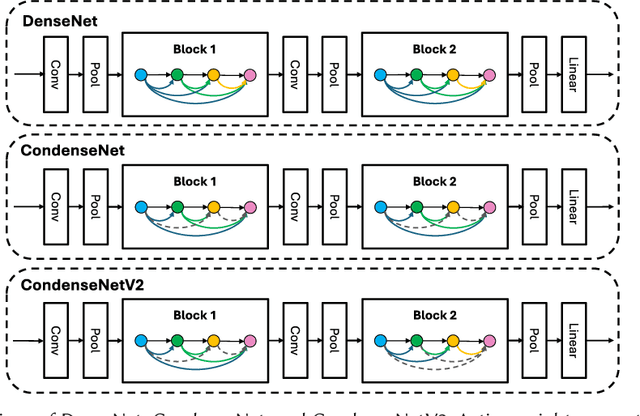

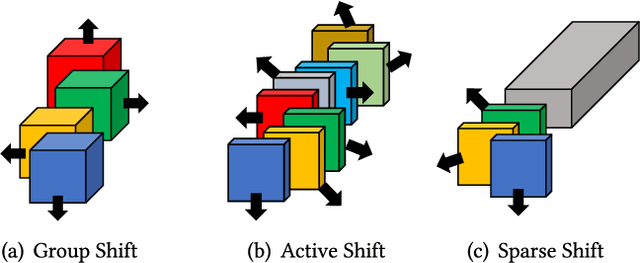

Abstract:Over the past decade, the dominance of deep learning has prevailed across various domains of artificial intelligence, including natural language processing, computer vision, and biomedical signal processing. While there have been remarkable improvements in model accuracy, deploying these models on lightweight devices, such as mobile phones and microcontrollers, is constrained by limited resources. In this survey, we provide comprehensive design guidance tailored for these devices, detailing the meticulous design of lightweight models, compression methods, and hardware acceleration strategies. The principal goal of this work is to explore methods and concepts for getting around hardware constraints without compromising the model's accuracy. Additionally, we explore two notable paths for lightweight deep learning in the future: deployment techniques for TinyML and Large Language Models. Although these paths undoubtedly have potential, they also present significant challenges, encouraging research into unexplored areas.
Dual-branch Cross-Patch Attention Learning for Group Affect Recognition
Dec 14, 2022Abstract:Group affect refers to the subjective emotion that is evoked by an external stimulus in a group, which is an important factor that shapes group behavior and outcomes. Recognizing group affect involves identifying important individuals and salient objects among a crowd that can evoke emotions. Most of the existing methods are proposed to detect faces and objects using pre-trained detectors and summarize the results into group emotions by specific rules. However, such affective region selection mechanisms are heuristic and susceptible to imperfect faces and objects from the pre-trained detectors. Moreover, faces and objects on group-level images are often contextually relevant. There is still an open question about how important faces and objects can be interacted with. In this work, we incorporate the psychological concept called Most Important Person (MIP). It represents the most noteworthy face in the crowd and has an affective semantic meaning. We propose the Dual-branch Cross-Patch Attention Transformer (DCAT) which uses global image and MIP together as inputs. Specifically, we first learn the informative facial regions produced by the MIP and the global context separately. Then, the Cross-Patch Attention module is proposed to fuse the features of MIP and global context together to complement each other. With parameters less than 10x, the proposed DCAT outperforms state-of-the-art methods on two datasets of group valence prediction, GAF 3.0 and GroupEmoW datasets. Moreover, our proposed model can be transferred to another group affect task, group cohesion, and shows comparable results.
 Add to Chrome
Add to Chrome Add to Firefox
Add to Firefox Add to Edge
Add to Edge